Exploring Urban XCO2 Patterns Using PRISMA Satellite: A Case Study in Shanghai
Abstract
:1. Introduction
2. Materials
2.1. Study Area
2.2. PRISMA Satellite Data
2.3. OCO Series Satellite Data
2.4. Other Ancillary Data
3. Methods
3.1. Sensitivity Analysis
3.2. FIMAP-DOAS Algorithm
3.3. Validation of the Retrieval Results
4. Results and Discussion
4.1. Sensitivity Analysis Results
4.1.1. Transmittance Spectrum Analysis
4.1.2. Sensitivity Analysis of CO2 Initial Conditions
4.1.3. Sensitivity Analysis of Cloud Layer Type
4.2. Spatial and Temporal Variations in XCO2
4.2.1. Cloud Removal Results
4.2.2. Cross-Validation of PRISMA Using OCO Series Level 2 Product
4.3. Discussion of Strengths and Limitations
5. Conclusions and Outlook
Author Contributions
Funding
Institutional Review Board Statement
Informed Consent Statement
Data Availability Statement
Acknowledgments
Conflicts of Interest
References
- Huang, T.Y.; Ding, L.P.; Yu, Y.Q.; Huang, L.; Yang, L.Y. From AR5 to AR6: Exploring research advancement in climate change based on scientific evidence from IPCC WGI reports. Scientometrics 2023, 128, 5227–5245. [Google Scholar] [CrossRef]
- McKay, D.I.A.; Staal, A.; Abrams, J.F.; Winkelmann, R.; Sakschewski, B.; Loriani, S.; Fetzer, I.; Cornell, S.E.; Rockstrom, J.; Lenton, T.M. Exceeding 1.5 °C global warming could trigger multiple climate tipping points. Science 2022, 377, 1171. [Google Scholar] [CrossRef]
- Rogelj, J.; den Elzen, M.; Höhne, N.; Fransen, T.; Fekete, H.; Winkler, H.; Chaeffer, R.S.; Ha, F.; Riahi, K.; Meinshausen, M. Paris Agreement climate proposals need a boost to keep warming well below 2 °C. Nature 2016, 534, 631–639. [Google Scholar] [CrossRef]
- Zhao, X.; Ma, X.W.; Chen, B.Y.; Shang, Y.P.; Song, M.L. Challenges toward carbon neutrality in China: Strategies and countermeasures. Resour. Conserv. Recycl. 2022, 176, 9. [Google Scholar] [CrossRef]
- He, C.P.; Ji, M.R.; Grieneisen, M.L.; Zhan, Y. A review of datasets and methods for deriving spatiotemporal distributions of atmospheric CO2. J. Environ. Manag. 2022, 322, 10. [Google Scholar] [CrossRef] [PubMed]
- Butz, A.; Guerlet, S.; Hasekamp, O.; Schepers, D.; Galli, A.; Aben, I.; Frankenberg, C.; Hartmann, J.M.; Tran, H.; Kuze, A.; et al. Toward accurate CO2 and CH4 observations from GOSAT. Geophys. Res. Lett. 2011, 38, 6. [Google Scholar] [CrossRef]
- Imasu, R.; Matsunaga, T.; Nakajima, M.; Yoshida, Y.; Shiomi, K.; Morino, I.; Saitoh, N.; Niwa, Y.; Someya, Y.; Oishi, Y.; et al. Greenhouse gases Observing SATellite 2 (GOSAT-2): Mission overview. Prog. Earth Planet. Sci. 2023, 10, 35. [Google Scholar] [CrossRef]
- Peiro, H.; Crowell, S.; Schuh, A.; Baker, D.F.; O’Dell, C.; Jacobson, A.R.; Chevallier, F.; Liu, J.J.; Eldering, A.; Crisp, D.; et al. Four years of global carbon cycle observed from the orbiting carbon observatory 2 (OCO-2) version 9 and in situ data and comparison to OCO-2 version 7. Atmos. Chem. Phys. 2022, 22, 1097–1130. [Google Scholar] [CrossRef]
- Eldering, A.; Taylor, T.E.; O’Dell, C.W.; Pavlick, R. The OCO-3 mission: Measurement objectives and expected performance based on 1 year of simulated data. Atmos. Meas. Tech. 2019, 12, 2341–2370. [Google Scholar] [CrossRef]
- Liu, Y.; Wang, J.; Yao, L.; Chen, X.; Cai, Z.; Yang, D.; Yin, Z.; Gu, S.; Tian, L.; Lu, N.; et al. TanSat mission achievements: From scientific driving to preliminary observations. Chin. J. Space Sci. 2018, 38, 627–639. [Google Scholar] [CrossRef]
- Saeki, T.; Saito, R.; Belikov, D.; Maksyutov, S. Global high-resolution simulations of CO2 and CH4 using a NIES transport model to produce a priori concentrations for use in satellite data retrievals. Geosci. Model Dev. 2013, 6, 81–100. [Google Scholar] [CrossRef]
- O’Dell, C.W.; Connor, B.; Bösch, H.; O’Brien, D.; Frankenberg, C.; Castano, R.; Christi, M.; Crisp, D.; Eldering, A.; Fisher, B.; et al. The ACOS CO2 retrieval algorithm—Part 1: Description and validation against synthetic observations. Atmos. Meas. Tech. 2012, 5, 99–121. [Google Scholar] [CrossRef]
- Taylor, T.E.; O’Dell, C.W.; Crisp, D.; Kuze, A.; Lindqvist, H.; Wennberg, P.O.; Chatterjee, A.; Gunson, M.; Eldering, A.; Fisher, B.; et al. An 11-year record of XCO2 estimates derived from GOSAT measurements using the NASA ACOS version 9 retrieval algorithm. Earth Syst. Sci. Data 2022, 14, 325–360. [Google Scholar] [CrossRef]
- Wu, L.H.; Hasekamp, O.; Hu, H.L.; Landgraf, J.; Butz, A.; aan de Brugh, J.; Aben, I.; Pollard, D.F.; Griffith, D.W.T.; Feist, D.G.; et al. Carbon dioxide retrieval from OCO-2 satellite observations using the RemoTeC algorithm and validation with TCCON measurements. Atmos. Meas. Tech. 2018, 11, 3111–3130. [Google Scholar] [CrossRef]
- Yang, D.X.; Zhang, H.F.; Liu, Y.; Chen, B.Z.; Cai, Z.N.; Lü, D.R. Monitoring carbon dioxide from space: Retrieval algorithm and flux inversion based on GOSAT data and using CarbonTracker-China. Adv. Atmos. Sci. 2017, 34, 965–976. [Google Scholar] [CrossRef]
- Broquet, G.; Bréon, F.M.; Renault, E.; Buchwitz, M.; Reuter, M.; Bovensmann, H.; Chevallier, F.; Wu, L.; Ciais, P. The potential of satellite spectro-imagery for monitoring CO2 emissions from large cities. Atmos. Meas. Tech. 2018, 11, 681–708. [Google Scholar] [CrossRef]
- Lauvaux, T.; Miles, N.L.; Richardson, S.J.; Deng, A.J.; Stauffer, D.R.; Davis, K.J.; Jacobson, G.; Rella, C.; Calonder, G.P.; DeCola, P.L. Urban Emissions of CO2 from Davos, Switzerland: The First real-time monitoring system using an atmospheric inversion technique. J. Appl. Meteorol. Climatol. 2013, 52, 2654–2668. [Google Scholar] [CrossRef]
- Xiang, R.; Yang, H.; Yan, Z.J.; Taha, A.M.M.; Xu, X.; Wu, T. Super-resolution reconstruction of GOSAT CO2 products using bicubic interpolation. Geocarto Int. 2022, 37, 15187–15211. [Google Scholar] [CrossRef]
- Roten, D.; Wu, D.E.; Fasoli, B.; Oda, T.; Lin, J.C. An interpolation method to reduce the computational time in the stochastic lagrangian particle dispersion modeling of spatially dense XCO2 retrievals. Earth Space Sci. 2021, 8, 28. [Google Scholar] [CrossRef] [PubMed]
- Nguyen, H.; Cressie, N.; Braverman, A. Multivariate spatial data fusion for very large remote sensing datasets. Remote Sens. 2017, 9, 142. [Google Scholar] [CrossRef]
- He, S.C.; Yuan, Y.B.; Wang, Z.H.; Luo, L.; Zhang, Z.L.; Dong, H.; Zhang, C.F. Machine Learning Model-Based Estimation of XCO2 with High Spatiotemporal Resolution in China. Atmosphere 2023, 14, 436. [Google Scholar] [CrossRef]
- Pignatti, S.; Palombo, A.; Pascucci, S.; Romano, F.; Santini, F.; Simoniello, T.; Amato, U.; Cuomo, V.; Acito, N.; Diani, M.; et al. The PRISMA hyperspectral mission: Science activities and opportunities for agriculture and land monitoring. In Proceedings of the IEEE International Geoscience and Remote Sensing Symposium (IGARSS), Melbourne, Australia, 21–26 July 2013; pp. 4558–4561. [Google Scholar]
- Acito, N.; Diani, M.; Alibani, M.; Corsini, G. Matched filter based on the radiative transfer model for CO2 estimation from PRISMA hyperspectral data. IEEE Trans. Geosci. Remote Sens. 2023, 61, 13. [Google Scholar] [CrossRef]
- Kai, Q.; Qin, H.; Kang, H.S.; Wei, H.; Fan, L.; Jason, C. Progress and prospect of satellite remote sensing research applied to methane emissions from the coal industry. Acta Opt. Sin. 2023, 43, 13. [Google Scholar] [CrossRef]
- Crisp, D.; Pollock, H.R.; Rosenberg, R.; Chapsky, L.; Lee, R.A.M.; Oyafuso, F.A.; Frankenberg, C.; O’Dell, C.W.; Bruegge, C.J.; Doran, G.B.; et al. The on-orbit performance of the Orbiting Carbon Observatory-2 (OCO-2) instrument and its radiometrically calibrated products. Atmos. Meas. Tech. 2017, 10, 59–81. [Google Scholar] [CrossRef]
- Romero-Lankao, P.; Gurney, K.R.; Seto, K.C.; Chester, M.; Duren, R.M.; Hughes, S.; Hutyra, L.R.; Marcotullio, P.; Baker, L.; Grimm, N.B.; et al. A critical knowledge pathway to low-carbon, sustainable futures: Integrated understanding of urbanization, urban areas, and carbon. Earth Future 2014, 2, 515–532. [Google Scholar] [CrossRef]
- He, J.Q.; Wang, S.J.; Liu, Y.Y.; Ma, H.T.; Liu, Q.Q. Examining the relationship between urbanization and the eco-environment using a coupling analysis: Case study of Shanghai, China. Ecol. Indic. 2017, 77, 185–193. [Google Scholar] [CrossRef]
- Wang, S.J.; Liu, X.P.; Zhou, C.S.; Hu, J.C.; Ou, J.P. Examining the impacts of socioeconomic factors, urban form, and transportation networks on CO2 emissions in China’s megacities. Appl. Energy 2017, 185, 189–200. [Google Scholar] [CrossRef]
- Feldman, A.F.; Zhang, Z.; Yoshida, Y.; Chatterjee, A.; Poulter, B. Using Orbiting Carbon Observatory-2 (OCO-2) column CO2 retrievals to rapidly detect and estimate biospheric surface carbon flux anomalies. Atmos. Chem. Phys. 2023, 23, 1545–1563. [Google Scholar] [CrossRef]
- Taylor, T.E.; O’Dell, C.W.; Baker, D.; Bruegge, C.; Chang, A.; Chapsky, L.; Chatterjee, A.; Cheng, C.; Chevallier, F.; Crisp, D.; et al. Evaluating the consistency between OCO-2 and OCO-3 XCO2 estimates derived from the NASA ACOS version 10 retrieval algorithm. Atmos. Meas. Tech. 2023, 16, 3173–3209. [Google Scholar] [CrossRef]
- Wunch, D.; Wennberg, P.O.; Osterman, G.; Fisher, B.; Naylor, B.; Roehl, C.M.; O’Dell, C.; Mandrake, L.; Viatte, C.; Kiel, M.; et al. Comparisons of the Orbiting Carbon Observatory-2 (OCO-2) XCO2 measurements with TCCON. Atmos. Meas. Tech. 2017, 10, 2209–2238. [Google Scholar] [CrossRef]
- Kiel, M.; Eldering, A.; Roten, D.D.; Lin, J.C.; Feng, S.; Lei, R.X.; Lauvaux, T.; Oda, T.; Roehl, C.M.; Blavier, J.F.; et al. Urban-focused satellite CO2 observations from the Orbiting Carbon Observatory-3: A first look at the Los Angeles megacity. Remote Sens. Environ. 2021, 258, 17. [Google Scholar] [CrossRef]
- Kurucz, R.L. High Resolution Irradiance Spectrum from 300 to 1000 nm. arXiv 2006, arXiv:astro-ph/0605029. [Google Scholar]
- Kochanov, R.V.; Gordon, I.E.; Rothman, L.S.; Wcislo, P.; Hill, C.; Wilzewski, J.S. HITRAN Application Programming Interface (HAPI): A comprehensive approach to working with spectroscopic data. J. Quant. Spectrosc. Radiat. Transfer 2016, 177, 15–30. [Google Scholar] [CrossRef]
- Zhao, L.; Chen, S.; Xue, Y.; Cui, T. Study of atmospheric carbon dioxide retrieval method based on normalized sensitivity. Remote Sens. 2022, 14, 1106–1125. [Google Scholar] [CrossRef]
- Zhu, Z.; Woodcock, C.E. Object-based cloud and cloud shadow detection in Landsat imagery. Remote Sens. Environ. 2012, 118, 83–94. [Google Scholar] [CrossRef]
- Zhu, Z.; Wang, S.; Woodcock, C.E. Improvement and expansion of the Fmask algorithm: Cloud, cloud shadow, and snow detection for Landsats 4–7, 8, and Sentinel 2 images. Remote Sens. Environ. 2015, 159, 269–277. [Google Scholar] [CrossRef]
- Qiu, S.; He, B.; Zhu, Z.; Liao, Z.; Quan, X. Improving Fmask cloud and cloud shadow detection in mountainous area for Landsats 4–8 images. Remote Sens. Environ. 2017, 199, 107–119. [Google Scholar] [CrossRef]
- Wang, S.; Zhou, B. Progress in aerosol measurements based on differential optical absorption spectroscopy method. J. Atmos. Environ. Opt. 2015, 10, 139–148. [Google Scholar]
- Frankenberg, C.; Platt, U.; Wagner, T. Iterative maximum a posteriori (IMAP)-DOAS for retrieval of strongly absorbing trace gases: Model studies for CH4 and CO2 retrieval from near infrared spectra of SCIAMACHY onboard ENVISAT. Atmos. Chem. Phys. 2005, 5, 9–22. [Google Scholar] [CrossRef]
- Frankenberg, C.; Thorpe, A.K.; Thompson, D.R.; Hulley, G.; Kort, E.A.; Vance, N.; Borchardt, J.; Krings, T.; Gerilowski, K.; Sweeney, C.; et al. Airborne methane remote measurements reveal heavy-tail flux distribution in Four Corners region. Proc. Natl. Acad. Sci. USA 2016, 113, 9734–9739. [Google Scholar] [CrossRef]
- Cusworth, D.H.; Duren, R.M.; Thorpe, A.K.; Eastwood, M.L.; Green, R.O.; Dennison, P.E.; Frankenberg, C.; Heckler, J.W.; Asner, G.P.; Miller, C.E. Quantifying global power plant carbon dioxide emissions with imaging spectroscopy. AGU Adv. 2021, 2, e2020AV000350. [Google Scholar] [CrossRef]
- Gelaro, R.; McCarty, W.; Suarez, M.J.; Todling, R.; Molod, A.; Takacs, L.; Randles, C.A.; Darmenov, A.; Bosilovich, M.G.; Reichle, R.; et al. The Modern-Era retrospective analysis for research and applications, version 2 (MERRA-2). J. Clim. 2017, 30, 5419–5454. [Google Scholar] [CrossRef]
- Cusworth, D.H.; Jacob, D.J.; Varon, D.J.; Miller, C.C.; Liu, X.; Chance, K.; Thorpe, A.K.; Duren, R.M.; Miller, C.E.; Thompson, D.R.; et al. Potential of next-generation imaging spectrometers to detect and quantify methane point sources from space. Atmos. Meas. Tech. 2019, 12, 5655–5668. [Google Scholar] [CrossRef]
- Thorpe, A.K.; Frankenberg, C.; Thompson, D.R.; Duren, R.M.; Aubrey, A.D.; Bue, B.D.; Green, R.O.; Gerilowski, K.; Krings, T.; Borchardt, J.; et al. Airborne DOAS retrievals of methane, carbon dioxide, and water vapor concentrations at high spatial resolution: Application to AVIRIS-NG. Atmos. Meas. Tech. 2017, 10, 3833–3850. [Google Scholar] [CrossRef]
- Rodgers, C.D. Retrieval of atmospheric temperature and composition from remote measurements of thermal radiation. Rev. Geophys. 1976, 14, 609–624. [Google Scholar] [CrossRef]
- Rodgers, C.D. Inverse Methods for Atmospheric Sounding: Theory and Practice; World Scientific: Singapore, 2000; Volume 2. [Google Scholar]
- Romaniello, V.; Spinetti, C.; Silvestri, M.; Buongiorno, M.F. A methodology for CO2 retrieval applied to hyperspectral PRISMA data. Remote Sens. 2021, 13, 4502. [Google Scholar] [CrossRef]
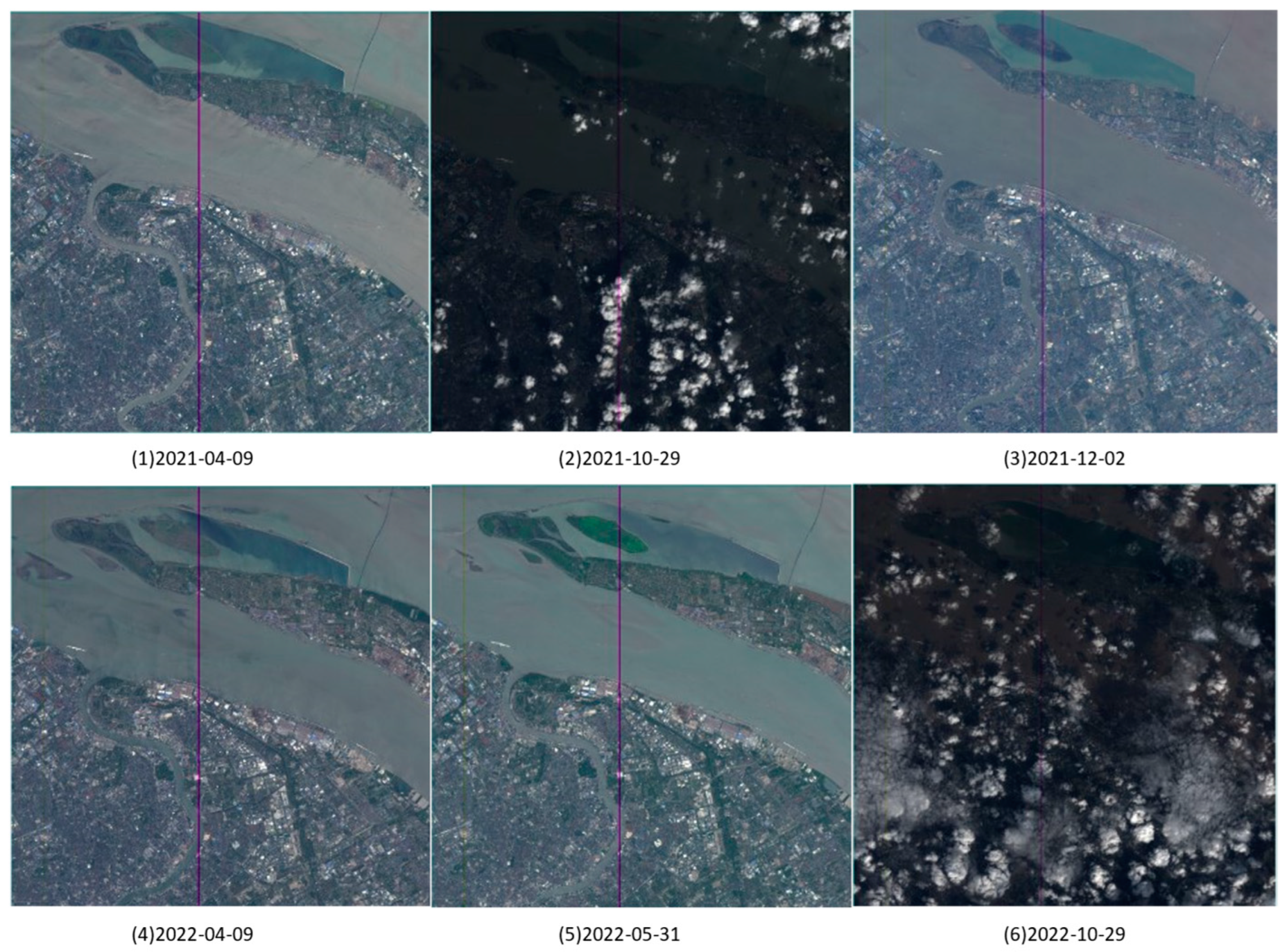
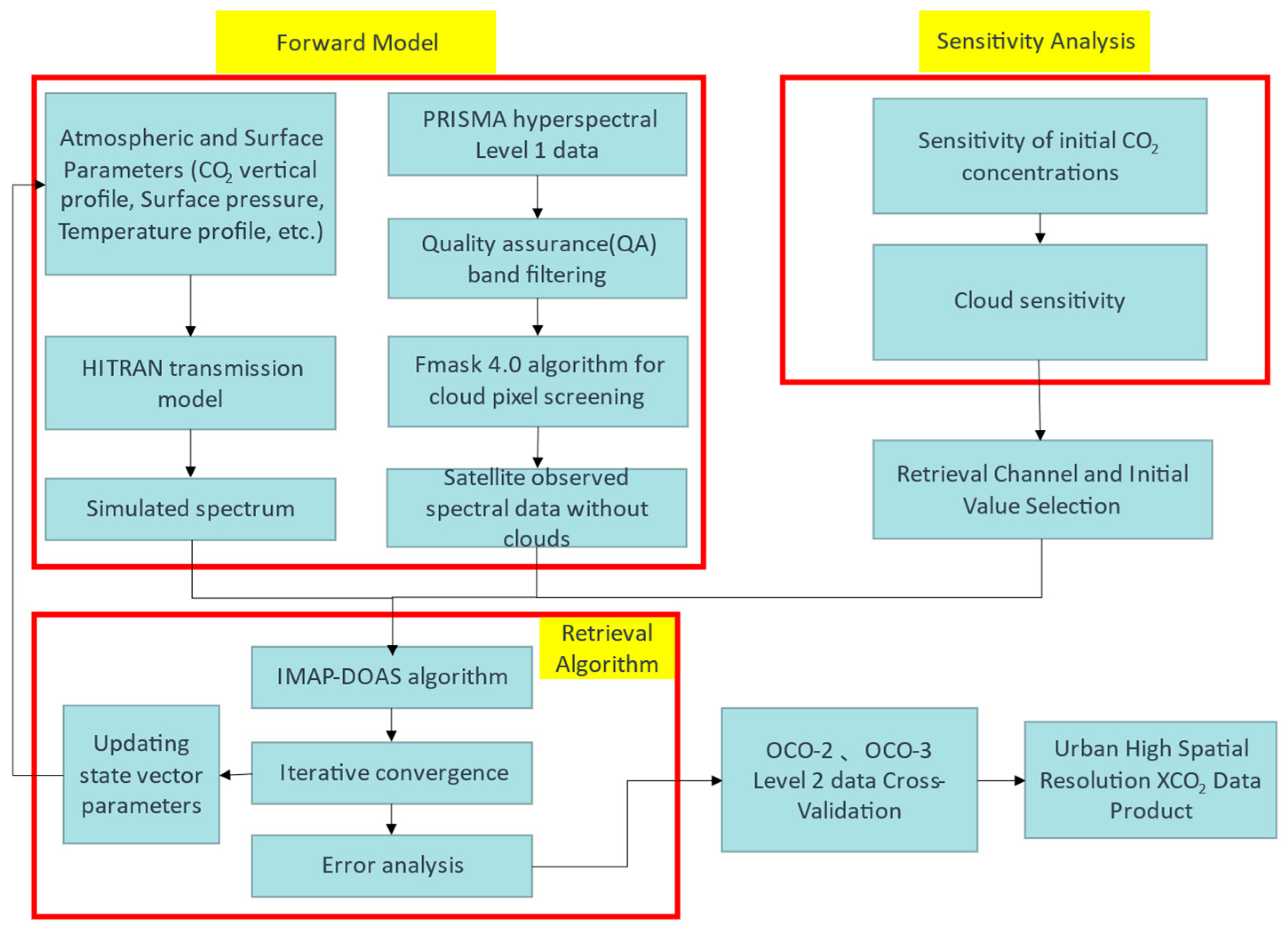
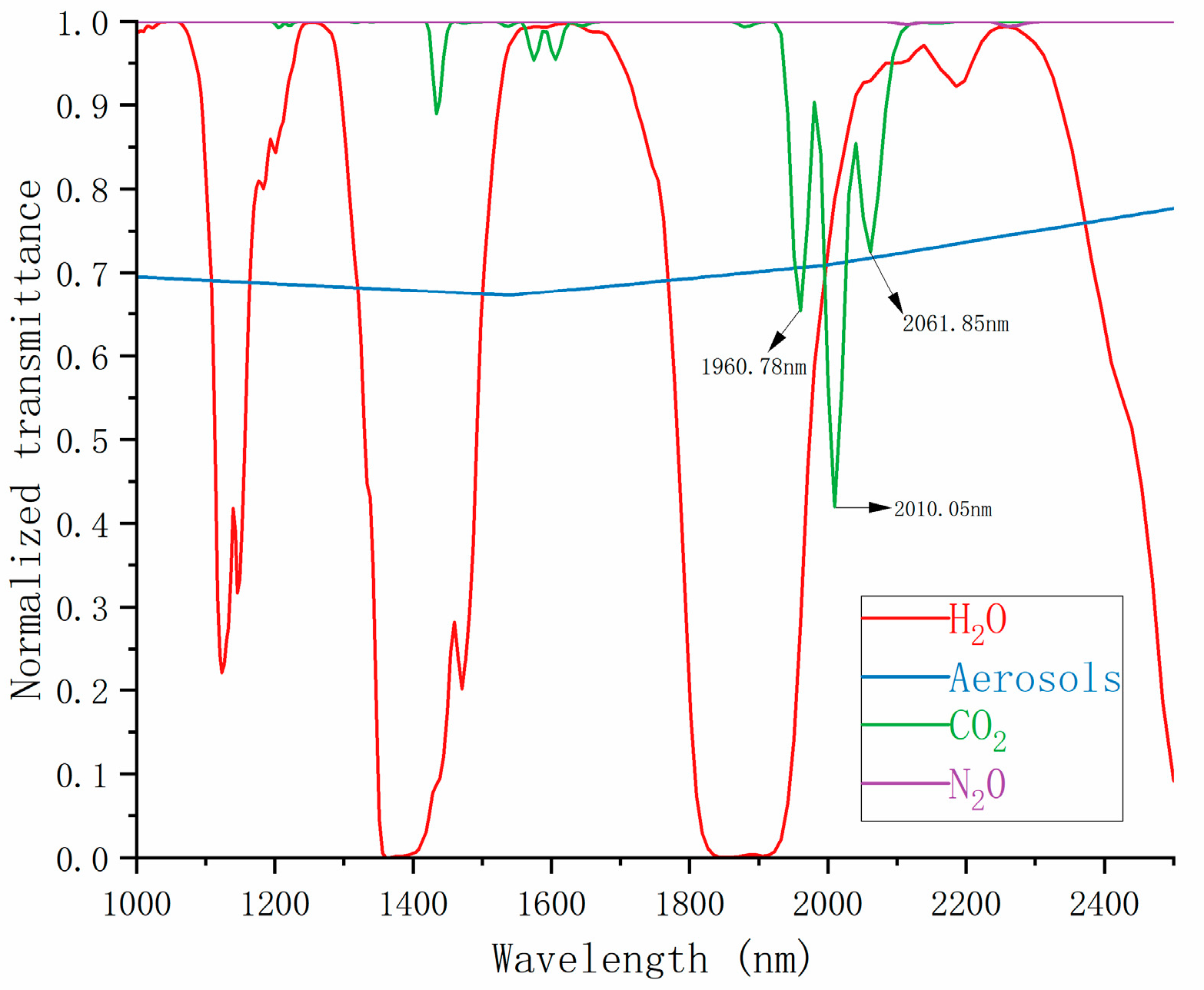
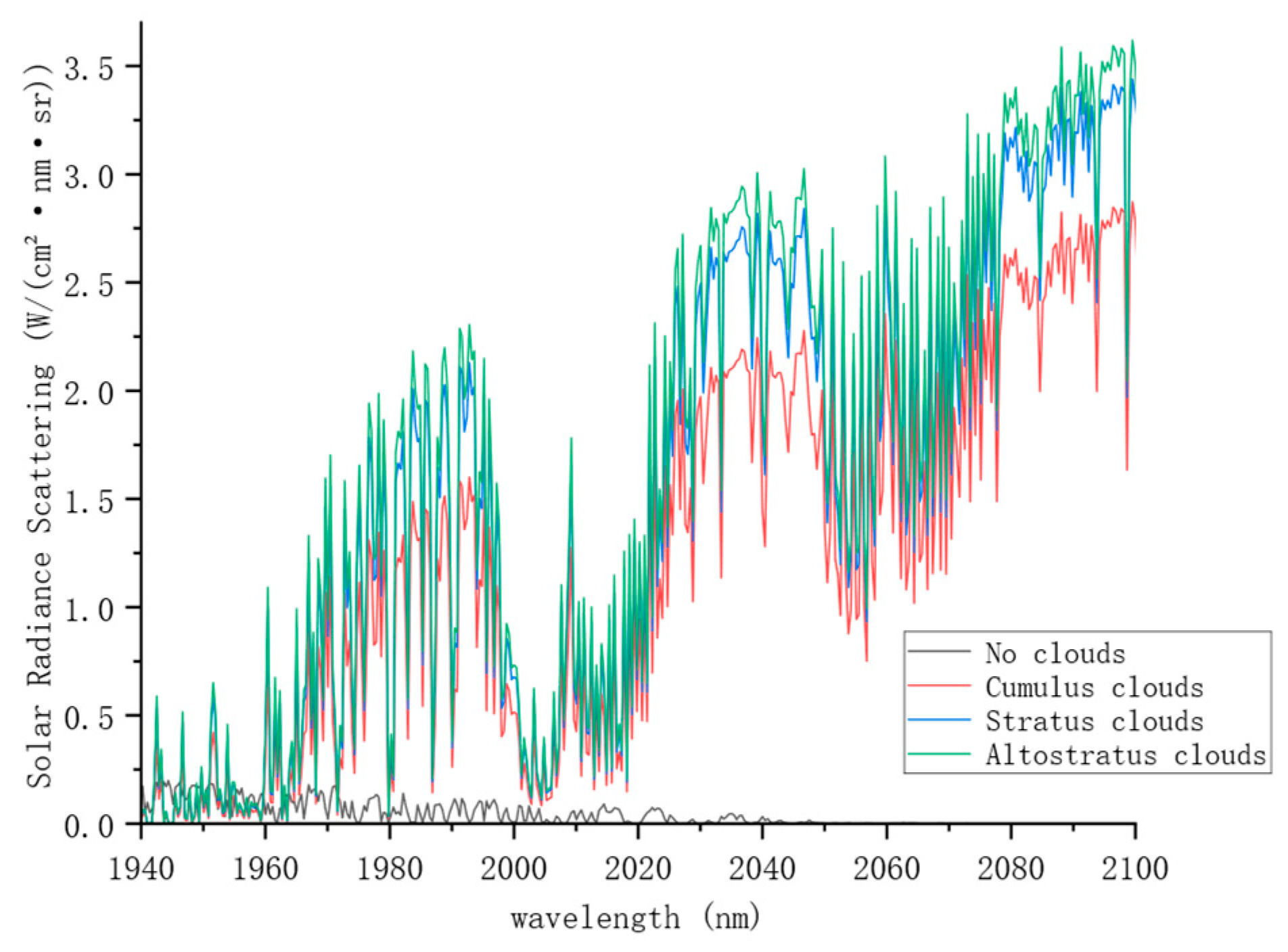
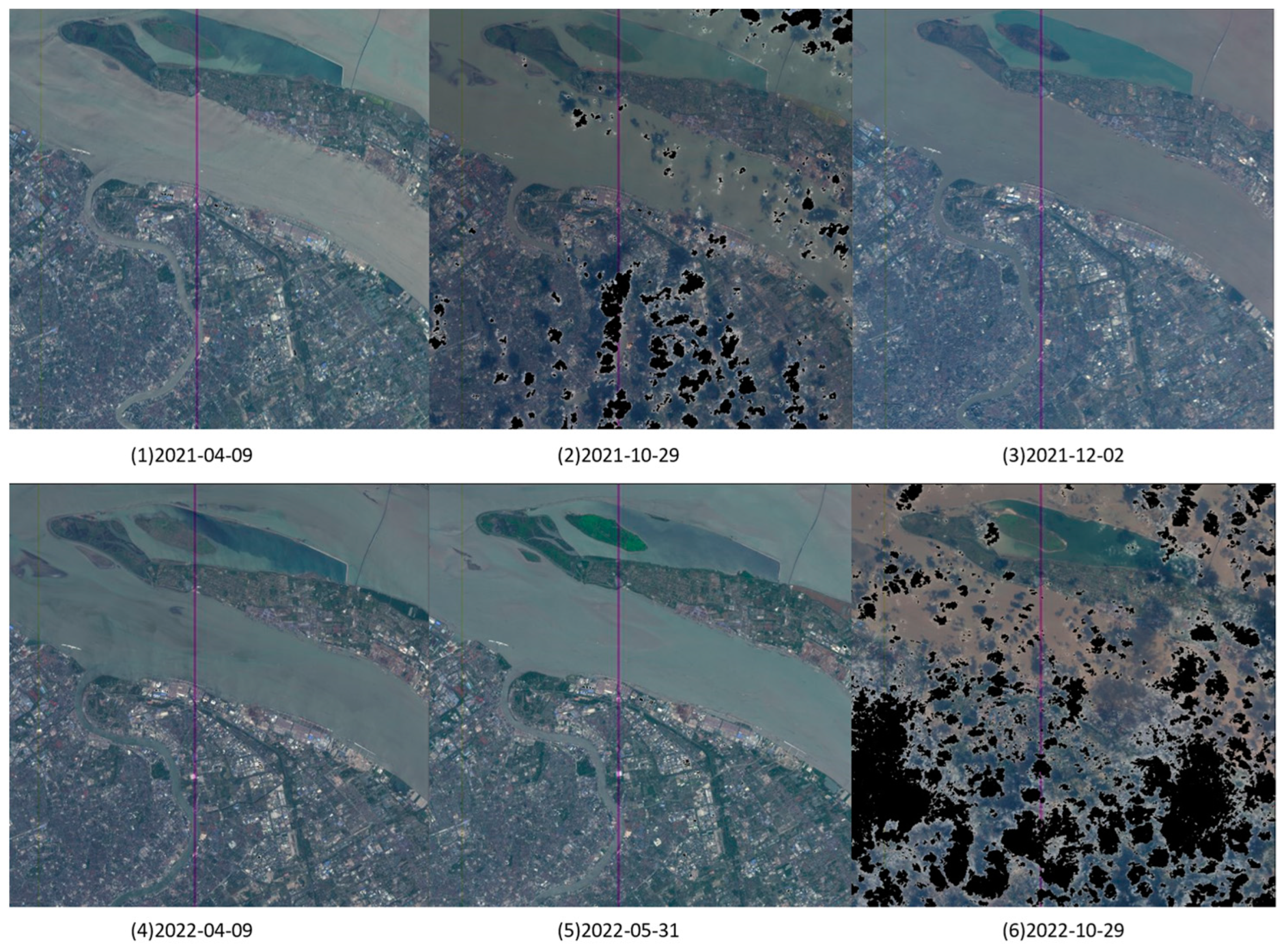

| Parameter | Description |
|---|---|
| Satellite Name | PRecursore IperSpettrale della Missione Applicativa (PRISMA) |
| Orbit Altitude (km) | 615 |
| Revisit Period (days) | 29 |
| Swath Width (km) | 30 |
| Spatial Resolution (m) | Hyperspectral: 30 Panchromatic: 5 |
| Spectral Range (nm) | VNIR: 400–1010 (66 bands) SWIR: 920–2505 (174 bands) PAN: 400–700 |
| Signal-to-Noise Ratio | VNIR: >160:1 (>450:1 at 650 nm) SWIR: >100:1 (>360:1 at 1550 nm) PAN: >240:1 |
| Average Spectral Resolution (nm) | VNIR: 11 SWIR: 10 |
| Initial Concentrations of CO2 | Average Deviation (%) | Peak Deviation (%) |
|---|---|---|
| 380 ppm | 0 | 0 |
| 390 ppm | −0.3 | −0.85 |
| 400 ppm | −0.60 | −1.67 |
| 410 ppm | −0.89 | −2.48 |
| Time | 2021-04 | 2021-10 | 2021-12 | 2022-04 | 2022-05 | 2022-10 | |
|---|---|---|---|---|---|---|---|
| Satellite | |||||||
| PRISMA | 412.51 ppm | 413.12 ppm | 414.51 ppm | 407.99 ppm | 413.75 ppm | 414.16 ppm | |
| OCO-2 | 413.55 ppm | 415.67 ppm | 409.14 ppm | 413.68 ppm | 415.51 ppm | ||
| OCO-3 | 414.92 ppm | 416.36 ppm | 411.21 ppm | 414.44 ppm | 416.63 ppm | ||
Disclaimer/Publisher’s Note: The statements, opinions and data contained in all publications are solely those of the individual author(s) and contributor(s) and not of MDPI and/or the editor(s). MDPI and/or the editor(s) disclaim responsibility for any injury to people or property resulting from any ideas, methods, instructions or products referred to in the content. |
© 2024 by the authors. Licensee MDPI, Basel, Switzerland. This article is an open access article distributed under the terms and conditions of the Creative Commons Attribution (CC BY) license (https://creativecommons.org/licenses/by/4.0/).
Share and Cite
Wu, Y.; Xie, Y.; Wang, R. Exploring Urban XCO2 Patterns Using PRISMA Satellite: A Case Study in Shanghai. Atmosphere 2024, 15, 246. https://doi.org/10.3390/atmos15030246
Wu Y, Xie Y, Wang R. Exploring Urban XCO2 Patterns Using PRISMA Satellite: A Case Study in Shanghai. Atmosphere. 2024; 15(3):246. https://doi.org/10.3390/atmos15030246
Chicago/Turabian StyleWu, Yu, Yanan Xie, and Rui Wang. 2024. "Exploring Urban XCO2 Patterns Using PRISMA Satellite: A Case Study in Shanghai" Atmosphere 15, no. 3: 246. https://doi.org/10.3390/atmos15030246






